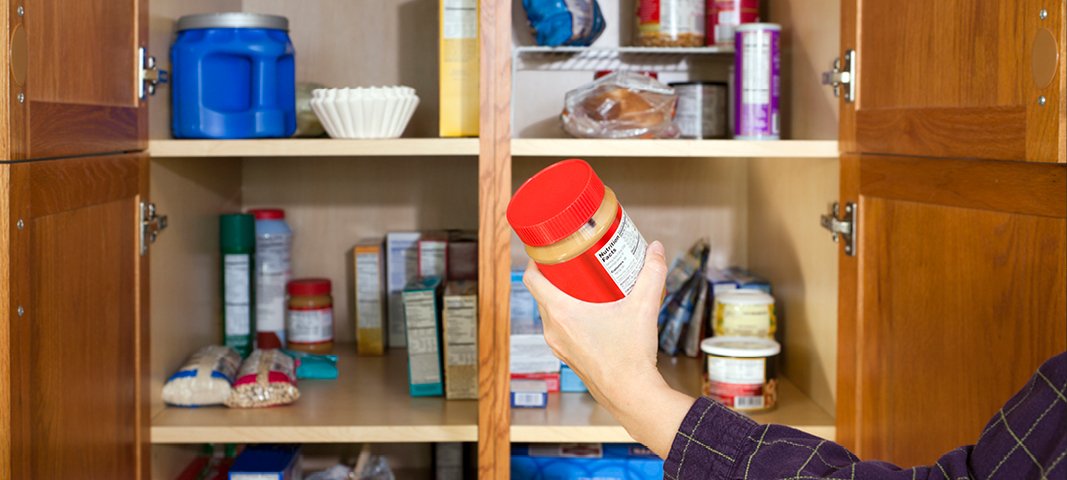Hunger Proof Your Home!
In the age of Internet and air-conditioning—where our cars are more comfortable than some of our grandparents’ homes were—life is one endless battle against calories. They make us second guess everything we put in our bodies: Are we eating too many? Are we burning enough? Are our calories empty? Are they wasted?
Calories have gotten so much negative press over the last few decades, it’s easy to forget how badly our bodies need them. But there is no question: survival is all about calories, especially in emergencies.
As survival instructor Tim MacWelch puts it: “Everything we do during an emergency boils down to two actions: saving calories and getting more calories.” That means eating at very least 1,800 calories per person, per day. For a family of three that’s 37,000 calories per week and 167,400 per month.
That is a whole lot of food to store away, but here’s the good news:
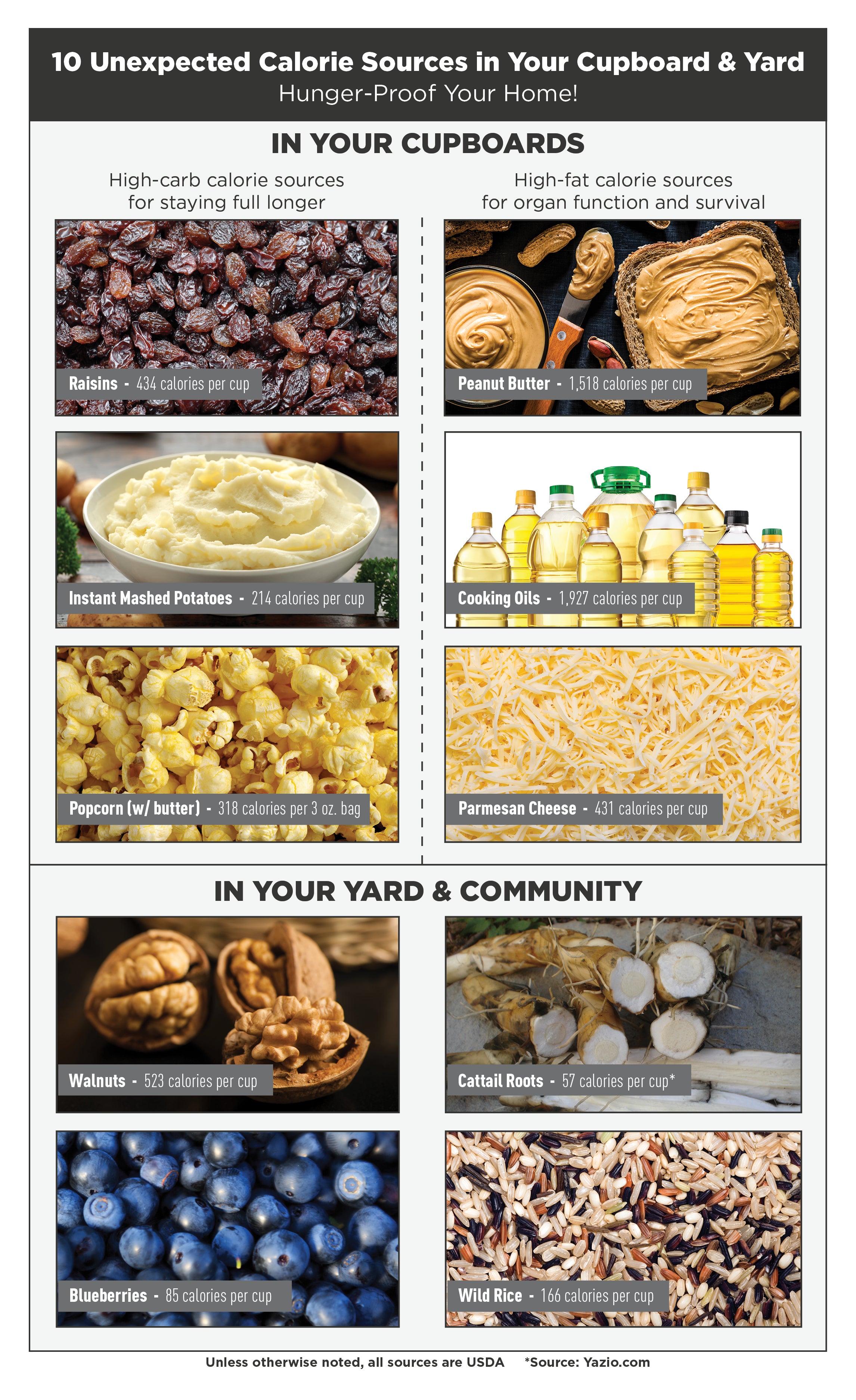
>>Click Here to Download the 10 Unexpected Calorie Sources" PRINTABLE PDF>>
If you find yourself short on calories when disaster hits (it can happen to anyone) there are some great overlooked sources most of us have lying around the house, yard, or even in our communities. You can safely lean on these when your supply runs short.
The Types of Calories to Prioritize for Your Emergency Supply
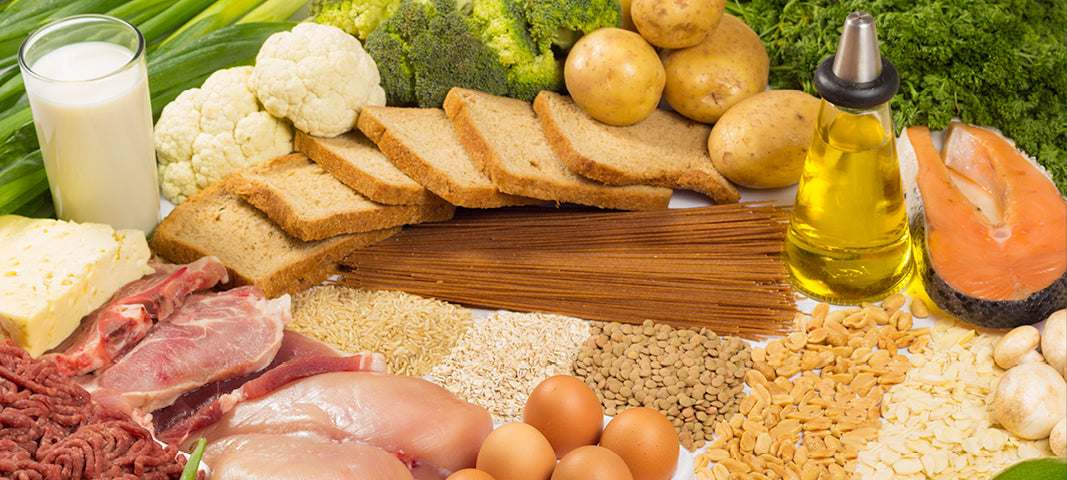
It’s worth mentioning that not all calories release energy in the same way—and they’re not all equally useful. When you count calories, you need to look beyond just the total number and focus on quality as well.
When it comes to your emergency supply, we suggest categorizing the calories you stockpile into at least three groups: fat-rich sources, carbohydrate-rich sources, and protein-rich sources (many foods contain two or all three). These are known as “macronutrients.” Since we’ve covered emergency protein sources extensively here, our discussion today will focus on the fat and carb-rich varieties.
In putting this list together, we sorted through dozens of well-known (and not so well-known) calorie sources that experienced preparedness specialists swear by. We winnowed that list down to the top 10 sources by prioritizing foods that are:
- High in calories
- Rich in fats and carbohydrates
- Easy to find—most may not even require a trip to the grocery store
- Not necessarily foods you’d think of in emergencies—these aren’t your go-to meats, grains, etc.
High-Carb Calorie Sources for Staying Active Longer
Along with protein, carbohydrates are the key to keeping your energy levels high through emergencies. They’re actually the first fuel source your body reaches for when it’s stressed or being exerted. Best of all, carbohydrates delay fatigue—giving you an extra boost to safely push your body just a little further.
1. RAISINS
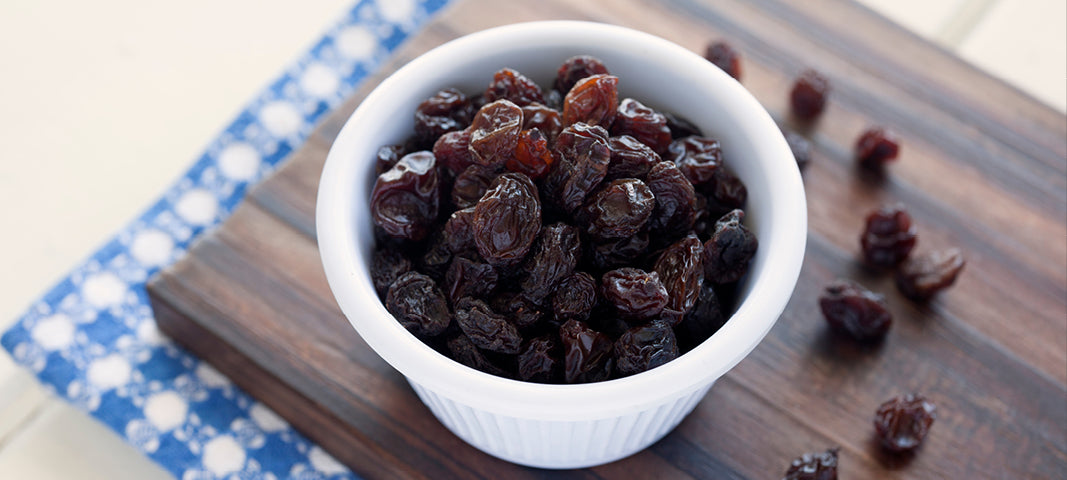
Raisins are calorie dense and mix well with many foods.
Raisins are one of those love-them-or-hate-them kinds of foods, but there’s no denying this shriveled little snack is packed with calories and carbs.
While that may be enough to keep dieters away, it makes raisins the perfect emergency food. They mix excellently with countless dishes, and because they contain so much fiber they help keep you fuller longer. In an emergency that means more time to focus on keeping you and your family safe rather than hunting down your next meal.
Calorie Content – 434 calories (per cup)
Carbohydrate Content – 115 grams (per cup)
Where to Find It – Most grocery stores in America…though you may prefer the slightly less common “golden” raisins, which are machine dehydrated and treated with antioxidant sulfur dioxide for a lighter, fruitier flavor and just a tiny bit more of a health bump due to flavonoid content.
How to Prepare It – In the spirit of “improvised” calorie sources, few things are better for quick fill-up than raisins in your cereal. Both foods are highly available and have decent shelf lives—raisins last unopened for up to a year. You can go with raisin bran (toss in extra raisins for even more calories), granola, or Wheaties if you’ve got them.
Or if you’ve got bread available, here’s a more calorie-dense take on the peanut butter sandwich that will keep you energized and satiated for hours (Source: allrecipes).
CINNAMON RAISIN PEANUT BUTTER SANDWICH
Ingredients
- ½ cup peanut butter
- 2 Tbsp honey
- 1 tsp ground cinnamon
- 4 Tbsp raisins
Directions
In a small bowl, mix together peanut butter, honey, and cinnamon
Spread about 2 Tbsp of the peanut butter spread over one side of one slice of bread. Sprinkle 1 Tbsp raisins evenly over peanut butter and place the second slice of bread. Repeat with remaining ingredients.
Other Important Nutrients – Potassium, iron, copper, and magnesium.
2. INSTANT MASHED POTATOES

Competitive runners call potatoes the "perfect carb" that deliver energy through exertion.
Here’s another food that will have dieters running for the hills.
One pouch of instant mashed potatoes yields 400 calories or more, requires only water to prepare, and can last up to 18 months. Instant potatoes from a dedicated emergency food company will last many years more.
Potatoes have been called “the perfect carb” by competitive runners who prize them for their carbohydrate density (they contain even more carbs than pasta). They deliver tons of energy through stressful and tiring circumstances.
Calorie Content – 214 calories (per cup)
Carbohydrate Content – 64 grams (one large potato)
Where to Find It – Most grocery stores in America. If you’re ambitious and want to cultivate your own, potatoes are also relatively easy to grow in a garden. Plant them four to six weeks before the last frost in spring and give them 75 to 135 days of growth before harvesting.
How to Prepare It – Add water, boil, and voila! Instant mashed potatoes pair best with meats and fresh veggies. If you’re out of those in an emergency (it happens), consider serving with grilled cheese sandwiches and a side of canned lima beans or frozen peas for extra protein.
Other Important Nutrients – Vitamin B6, vitamin C, phosphorus, and manganese.
3. POPCORN
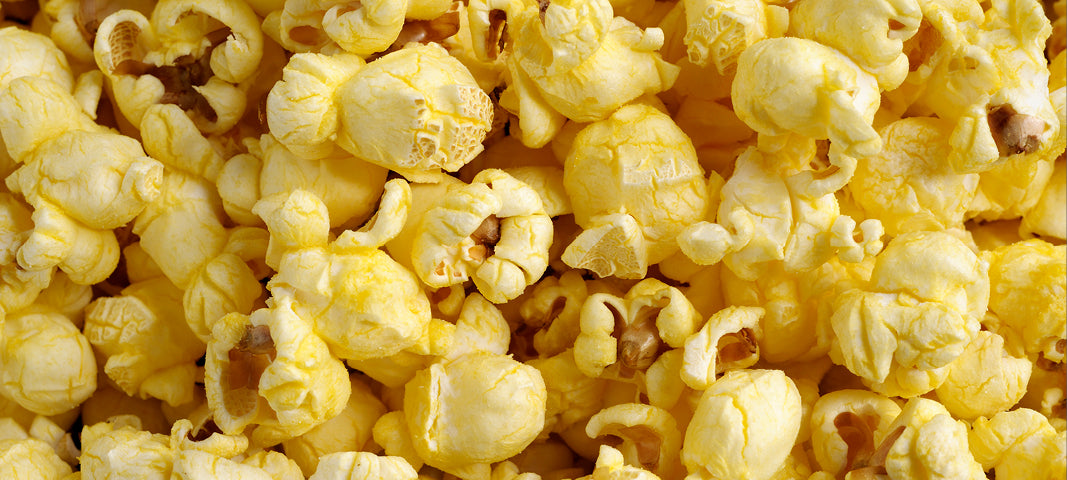
Studies show that popcorn is one of the most filling snacks.
Surprised to see popcorn on this list? To be honest, so are we. As we reviewed all our high-calorie candidates, popcorn kept sneaking it’s way back into our conversations. Why?
For starters, it’s surprisingly high in calories, especially if you make it the old-fashioned way: popped in oil and sprinkled with butter. Studies conducted on popcorn have found that calorie for calorie it’s one of the most filling snacks there is.
And considering how easy it is to make and how common it is in American kitchens, this is no-brainer back up when you’re out of calories in an emergency.
Calorie Content – 318 calories (per 3 oz bag)
Carbohydrate Content – 63 grams (per 3 oz bag)
Where to Find It – Most grocery stores in America.
How to Prepare It – You can microwave, oil pop, or even air pop it.
Here’s a fantastic, high-calorie popcorn recipe we love from bonappetit.com that includes two items from this list—three if you switch out pecans with walnuts. It’s a perfect little emergency confection for brightening up tough days…or any day for that matter!
If this recipe doesn’t strike your fancy, you can always try melting Parmesan cheese over popcorn for another delicious, filling calorie load-out.
SPICED SURVIVAL POP
Ingredients
- 5 cups popped popcorn
- 2 cups pecans (or switch out with walnuts)
- 2 Tbsp butter
- 1 tsp ground cinnamon
- 1 tsp salt
- 1 tsp paprika
- 1 tsp turmeric
- 1/2 tsp cayenne pepper
- ½ tsp ground ginger
- ½ tsp ground nutmeg
- 2 Tbsp pure maple syrup
- 1 cup raisins
Directions
Preheat oven to 300°. Toss popcorn with nuts.
Melt butter in a small skillet over low heat. Add cinnamon, salt, paprika, turmeric, cayenne, ginger, and nutmeg and cook, stirring, 30 seconds. Stir in maple syrup. Pour over popcorn mixture and mix to coat.
Spread out on a rimmed baking sheet and bake, tossing every 10 minutes, until dry and nuts are toasted, 30–40 minutes. Let cool; toss in raisins.
Other Important Nutrients – Fiber, B vitamins, magnesium , and manganese.
High-Fat Calorie Sources for Survival
Fats are critical to your health in many of the same ways proteins and carbs are. They keep you full and satiated, keep your organs functioning, contain acids that protect against disease, and help increase your body’s energy levels. And while your body may not tap fat for energy as quickly as carbs and protein, they do serve as an effective long-term energy storage. Here are a few fat-rich calorie sources you can rely on when all else fails.
4. PEANUT BUTTER
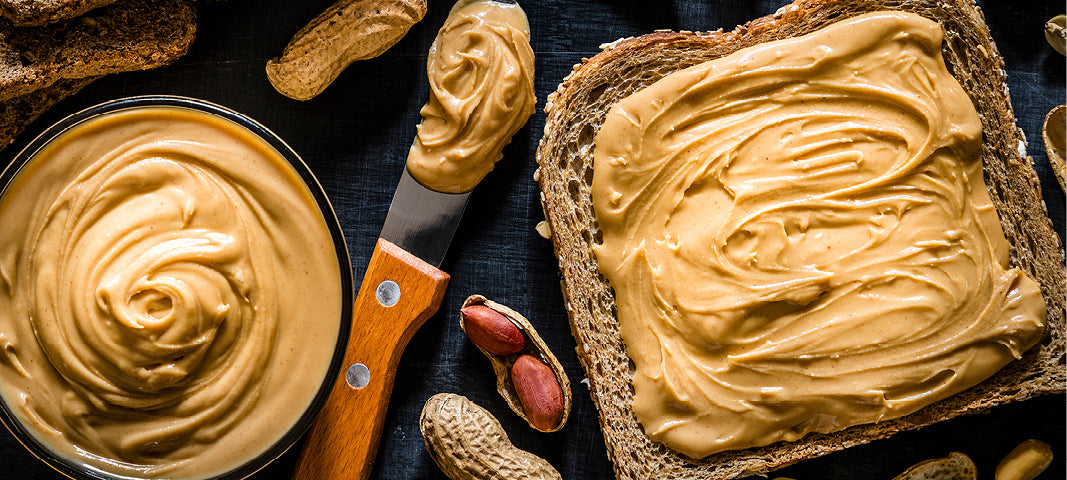
Professional athletes love peanut butter for its anti-inflammatory and satiating properties.
Topping the list of fatty calorie sources is peanut butter, and why not? It’s possibly the most ubiquitous food in America, apart from bread and milk (and let’s be honest, at least half of that bread is just a vehicle for shoving peanut butter in our mouths).
What’s more, peanut butter is a legitimate performance enhancer. Just ask the many professional athletes who integrate it into their daily diet.
They eat it for the same reason you should in an emergency: it helps with inflammation, it’s a good source of an amino acid called arginine that helps keep the blood vessels flexible, it strengthens the immune system, and like most of the foods on this list, it keeps you full.
Calorie Content – 1,518 calories (per cup)
Fat Content – 130 grams (per cup)
Where to Find It – Most grocery stores in America, and you’ve got lots of options. From a pure health standpoint, Peter Pan-brand creamy peanut butter is reported to have one of the highest calorie counts, while organic brands tend to have the lowest.
Our general advice when it comes to emergencies is to shop for what you like. Looking forward to food during a disaster goes a long way toward lifting your spirits.
How to Prepare It – Put it on bread, add something sweet and sticky, and enjoy.
If you’re out of peanut butter but stocked up on peanuts, making it at home is a cinch (if you have power available). All you need are nuts, salt, sweetener, some vegetable oil (optional), and a food processor or high-powered blender like a Vitamix, Blendtech, or Ninja. Here’s a great peanut butter recipe with some fun variations.
Other Important Nutrients – Protein, magnesium, phosphorus, and vitamin B6.
5. COOKING OILS

Cooking oils of all kinds help add caloric value to meals.
Not so much a food on its own as a implement for cooking, the oils in your cupboard will add calories and make certain foods more filling (not to mention better tasting).
While foods with high fiber and water content fill the stomach more effectively, fats cause your body to produce gastrointestinal hormones that satiate hunger. The best scenario in an emergency is that you’re able to cook high-water, high-fiber foods (frozen or dehydrated vegetables, for example) with those fatty oils to help fill up on nutrients and keep your appetite in check.
Calorie Content – Cooking oils (peanut, vegetable, canola, olive) 1,900 to 2,000 calories (per cup)
Fat Content – Cooking oils (peanut, vegetable, canola, olive) 200 to 225 grams (per cup)
Where to Find It – Most grocery stores in America.
How to Prepare It – You’ll need heat, if it’s available. Then just pour and simmer.
Other Important Nutrients – Vitamin E, vitamin K.
6. PARMESAN CHEESE

Parmesan cheese is a high-calorie, high-protein, and high-fat food.
Like peanut butter and popcorn, Parmesan cheese is one of those foods that always seems to be hanging around the kitchen. It’s hard to imagine my crisper drawer without a bag of Parmesan—raise your hand if you’re with me! I’m not always quite sure how old the bag is, but since Parmesan can last up to a year, I rarely think twice about eating it.
- Calorie Content – 431 calories (per cup)
- Fat Content – 29 grams (per cup)
- Where to Find It – Most grocery stores in America.
- How to Prepare – The ultimate mix in. What food isn’t better with cheese!
- Other Important Nutrients – Vitamin B12, riboflavin, vitamin A, calcium.
Improvised High-Calorie Sources in Your Yard and Community
7. WALNUTS
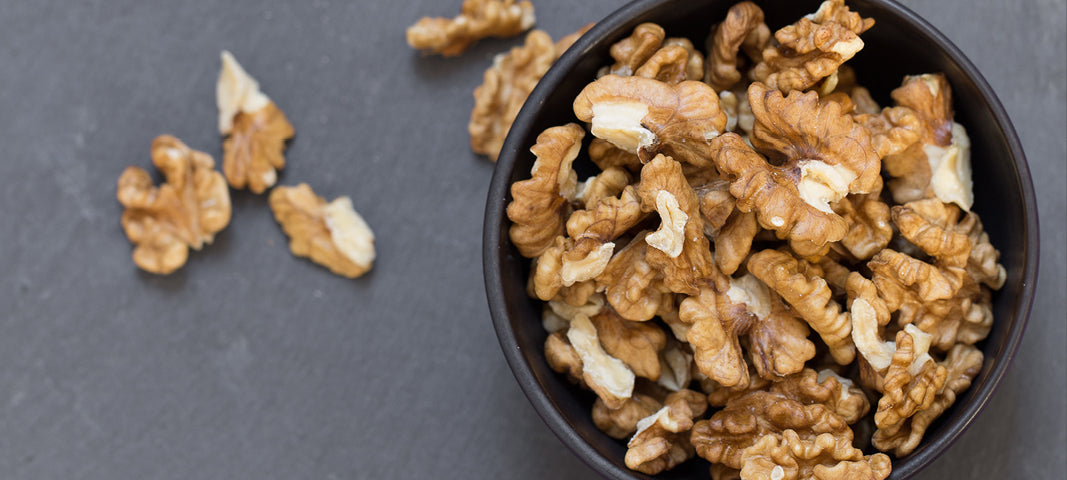
Walnuts are high in protein and fats and can cut the time it takes to recover from physical exertion.
The walnut is an amazing little food, rich in two of the three macronutrients critical to human health: protein and fat. They’re also super high in antioxidants that boost muscle repair and cut the time it takes to recover from physical exertion—a helpful property in disaster scenarios.
The best part about walnuts (and many other nuts) is that they’re available for free in trees and on the ground in many regions of the US. If grocery stores shut down or you’re isolated from supplies, you could do a lot worse than foraging wild walnuts from your yard or community.
Calorie Content – 523 calories (per cup)
Where to Find It – Walnuts grow in regions all over the country but thrive particularly well in parts of the central and eastern US.
How to Prepare – Put on a pair of gloves to avoid tannins and collect your walnuts from under a walnut tree. The best time of year for harvesting is September to early October. If you can leave a finger depression in the husk, the nut is mature.
Remove the husks, wash the shells, then dry and cure for two to three weeks. Once cured, store your walnuts in a cool, dark place—or even better, shell them and freeze the meat. They last a long time stored this way.
Other Important Nutrients Inside – Vitamin B6, vitamin E, folic acid, phosphorus.
Be careful of…Allergic reactions. If you have any tree nut allergies, it’s better to play it safe and avoid walnuts.
Also, try to avoid harvesting nuts that look like they’ve been handled by squirrels or other disease carrying pests.
8. WILD BLUEBERRIES

Combined with walnuts, blueberries provide most of the nutrients needed to survive.
Blueberries aren’t particularly high in calories , but I mention them on this list because of how perfect an emergency food they become when paired with walnuts (or other nuts).
You’ve heard about people living off nuts and berries, right? Well, turns out there’s something to it. While it’s not recommendable to live off wild blueberries and walnuts for long periods of time, they do provide many of the nutrients needed to survive.
In particular, blueberries are rich in many of the micronutrients (vitamins and minerals) needed for survival like vitamin C, vitamin B6, and potassium while walnuts are rich in the macronutrients protein and fat (they also contain some carbohydrates).
Together, these foods form about as close to a complete nutritional profile as you’re going to find lying around on the ground.
Calorie Content – 85 calories (per cup)
Where to Find It – Blueberry bushes grow wild in most states in the US.
How to Prepare – Picking blueberries is easy relative to their thornier berry counter parts.
The real trick is determining which berries are ripe—they don’t ripen after they’re picked.
Start by softly running a hand under the berry. Ripe berries need little more than that to fall off the bush. If they require pulling or are white or pink, they are not ready to pick.
Other Important Nutrients Inside - Vitamin C, vitamin B6, and potassium, antioxidants, and phytonutrients.
Be careful of…Fruits that appear to be blueberries but are actually toxic. Nightshade is one of the most dangerous lookalikes. You can recognize nightshade by their foliage: leaves can be green to purple-tinged and produce a star-shaped yellow and purple flower. Many are hairy and odorous.
9. CATTAILS
Cattails may not look very appetizing, but they’re quite edible and rich in calories. They’re an amazing plant—touted by survivalists as a source of food, water, shelter, and fire. The tips of cattails can be eaten, as can the bottoms of the stalks and the roots.
Calorie Content – 57 calories (per cup)
Where to Find It – Any state with standing water, from Alaska to Florida.
How to Prepare

- Roots: These are best in fall and winter. Clear out the smaller roots and expose the thick stem (called a rhizome). Cook this in about any way you’d like. Once the root softens, it eats a lot like an artichoke.
- Stalks: These are best harvested in the spring. The white bottoms of the stalks tend to be better eating. Cook and serve like asparagus.
- Tips: In the spring, cattail tips can be picked, boiled, and eaten like corn (add plenty of butter and salt!).
Other Important Nutrients Inside – Potassium, iron, phosphorus, magnesium, manganese, vitamin B6, and vitamin K.
Be careful of…The waters where cattails grow. They’re often found in standing waters like lakes, ponds, and even ditches—and their habitat can be thick with microbes you don’t want to get anywhere near. Always wash cattails thoroughly, especially the portions in contact with water.
10. WILD RICE
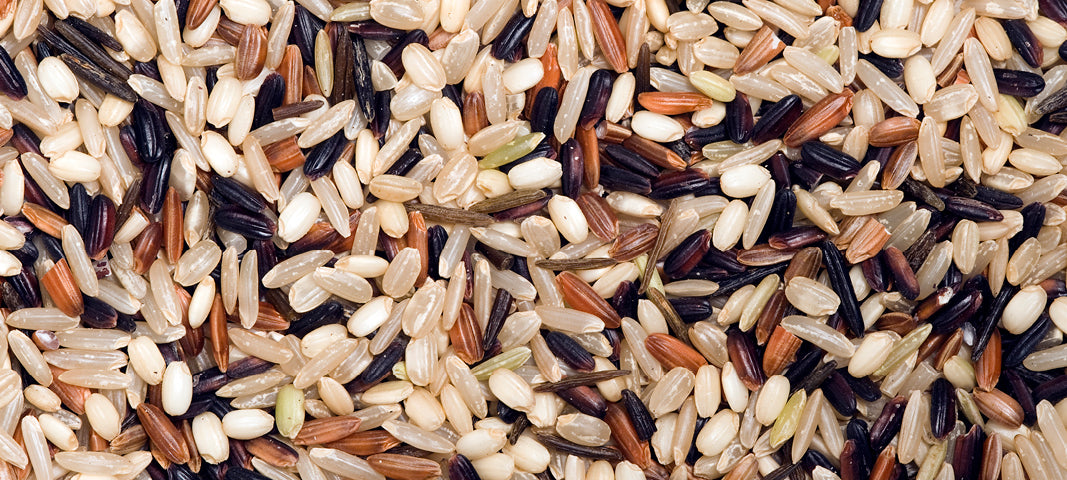
Wild rice is a wonderful source of calories and nutrition that grows in certain regions of the US and requires some equipment and knowledge to harvest.
Wild rice (along with every other variety) is used the world over to add calories and heft to meals. A cup serves up a generous 120 grams of carbohydrates, 10 grams of fiber, and 24 grams of protein.
If you’re running low on food in an emergency, you should know there’s rice growing wild in regions all over the US. It’s worth doing a little homework beforehand to discover if your area’s one of them—we recommend it as part of your preparations, right alongside creating an emergency plan, disaster-proofing your home, etc.
Unlike the other items listed here, harvesting wild rice can takes more effort and equipment—often requiring a canoe. Depending on where you live, this can make it difficult to harvest rice immediately after an emergency.
However, if you do live near wild rice and have the equipment and means, it can be a wonderful source of food when times get tough.
NOTE: In some areas you need a license to harvest wild rice. Check with your state’s department of natural resources for more information.
Calorie Content – 166 calories (per cup)
Where to Find It – Throughout Canada and much of the American East and South, from the Atlantic Coast to the Gulf Coast including Florida and Texas. Varieties are also found surrounding the Great Lakes regions.

How to Prepare – Wild rice can be harvested through late summer to mid fall. Start with the right equipment: unless you are harvesting in very shallow waters, you will need a canoe. You’ll also want to take wild rice sticks made of a light type of wood like cedar that will reduce damage to rice stalks and not wear you out as quickly.
Wild rice often grows well in waters between six inches and three feet deep. Look for it in places with mucky, organic bottoms and very gentle currents. These areas are often near an inlet or outlet of a lake, in shallow bays, or along shorelines.
You need two people to harvest rice from a canoe: one to row and another with rice sticks. The person with rice sticks gently bends the rice stalk over the canoe and brushes it, releasing rice into the canoe bed. If little or no rice falls then the rice is not ready
Once you’re done harvesting, place the rice in a container. Soak it for 24 hours or dry it in the sun.
Preparing wild rice for kitchen readiness requires a few tools and is complicated for beginners. If you’re willing to learn, prepping wild rice can be done at home. However, you may want to check your area for experienced practitioners who can quickly prep harvested rice for a small fee.
Other Important Nutrients Inside – Vitamin B6, folate, phosphorus, manganese.
Be careful of…Hitting the rice too hard to extract it. Ripe rice will fall gently and requires little manipulation. If you hit the stalks too hard you’ll find yourself with rice that’s tough to prep and tough to eat AND you might permanently damage the stalks.
With a little bit of research and effort, you’ll quickly find that calories are everywhere, from your kitchen to your yard and in areas nearby in your community. They’ll help you get by when your emergency food supply runs low and will keep you comfortable and safe when disaster strikes.
God bless and stay safe out there!

